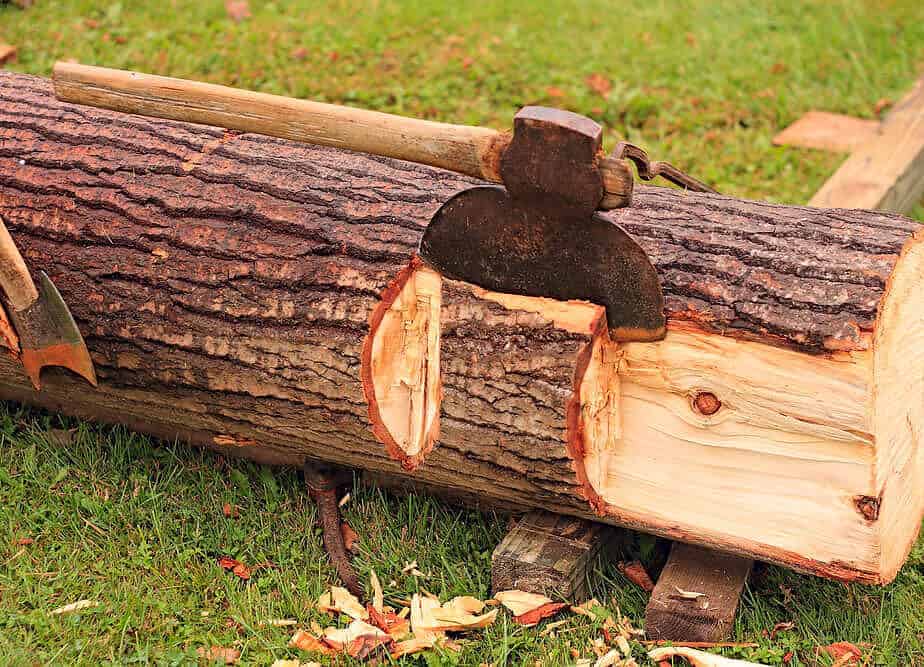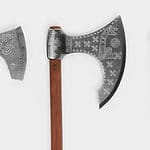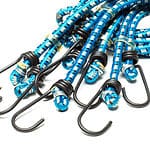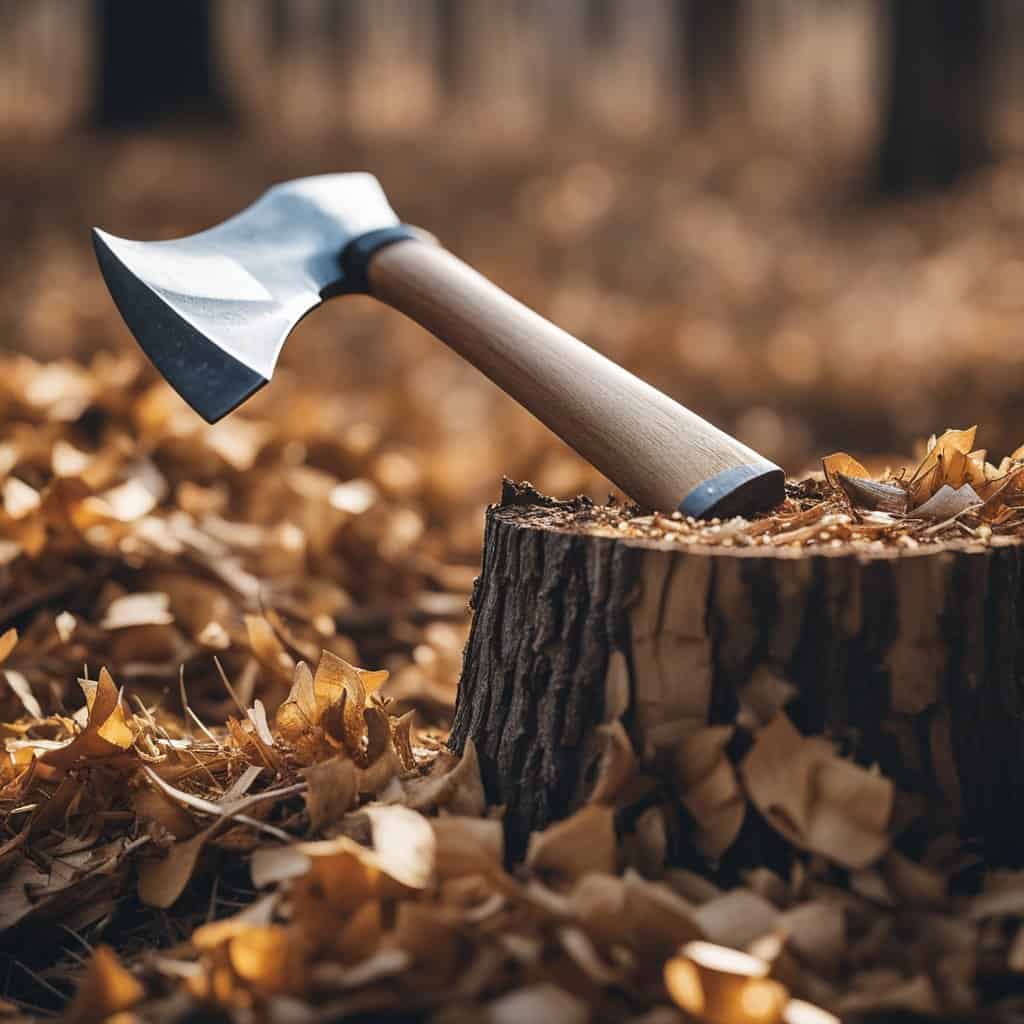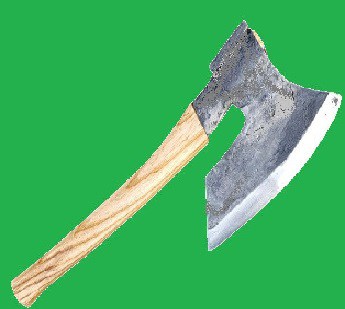Broad axes have a rich history and have been an integral tool since ancient times for manufacturing timber, shipbuilding, timber framing, railroad ties, and log building. Though they have been around for a long time, they are still a prevalent part of modern woodworking and carpentry.
Used for hewing logs, broad axes come in two types — one with two bevelled edges and the other with a single bevelled side. The handle can be straight or curved away from the flat side to ensure the hewer, or the person shaping and cutting the wood, achieves the perfect stance when shaping timber.
This article explores the edge types, handle lengths, uses, and costs of broad axes to ensure you always choose the right tool for the job.
Table of Contents
Two Types of Edges on Broad Axes
The axes from Viking times have refined and the term broad axe represents two types of axes used in woodworking; chopping broad axes and carving broad axes. While both are used for hewing logs, the differences lie in their edges or blades.
#1 Carving Broad Axes: One Side Flat, Other Side Beveled
Carving broad axes have one flat side and one bevelled side. When shopping for or researching these axes, you may come across manufacturers that refer to the bevelled side as a:
- single bevel;
- chisel-edged axe;
- basilled edge; or
- side axe.
The flat blade helps ensure the hewn surface is flat. However, you can only use a single-bevelled axe in one direction. They often have a handle that curves away from the flat side of the blade to allow you to achieve the proper stance for a safe, smooth cut. Carving broad axes come in left and right-handed versions, so ensure you purchase the axe that works with your dominant hand.
#2 Chopping Broad Axes: Both Sides Beveled
The other broad axe has bevelled sides and both sides of the blade and is often called a double-bevel axe. They typically come with a straight handle, allowing you to swing the axe with either side against the wood.
When working with chopping broad axes, the final cut will be scalloped, making it perfect for hewing, chopping, or notching.
If you plan to use a broad axe for hewing, you should start by chopping notches into the side of the log along a marked line. This process is known as scoring and helps you with the next step. You’ll then remove the pieces of wood between the notches with the axe, called joggling, before hewing the remaining wood to the pre-marked line.
Broad Axe Handle Length
Both broad axes, carving and chopping, have been around for over one thousand years. While the blade design has not changed, the available handle lengths have varied.
In various European countries, broad axe handles reached a whopping four feet in length, but in parts of North America, they can be as short as 15 inches. However, since the 19th century, in the U.S.A., the most common broad axe handles span from 20 to 22 inches. Most modern versions stick to this length because it provides enough space to obtain the perfect grip and stance.
Broad Axe Uses
A broad axe is often called a hewing axe due to its primary purpose, hewing, which involves turning round logs into flat-edged timber used in various construction projects. For a step by step guide on how to hand hew click here.
Classically, hewers used broad axes to create square timbers for home braces and railroad ties. Once a felled tree lands, the axe is used to score the timber before powerfully wielding it to split the wood along the created line, resulting in a squared edge. Then, the hewer flipped the log to do the same thing on the other side. During this time, shipbuilders hewed octagonal timber to use as masts and depending on the user’s skill, pioneers used the broad axe to make flooring planks.
Hewing a log was the type of carpentry skill available before industrial sawmills and power tools. If you’ve ever entered a building constructed from hand-hewn timber, you might be able to see the strokes of the broad axe along the grain.
This medium-sized hand tool is not seen much in manufacturing or production today. Typically, you will find broad axes used in construction projects in undeveloped regions or restoration carpentry of hand-hewn cabins.
Hewing Broad Axe VS Broad Axe: A Comparison
These days, you’ll often find the terms hewing broad axe and broad axe used interchangeably. Why? As they are essentially the same thing! A broad axe is the axe of choice for hewing logs. However, you can find different hewing axes that do not fit the broad axe category, which is an axe with a wide blade up to 13 inches. These axes include:
- Carving axe — This hewing axe is smaller than a broad axe, and you can use it with just one hand. It’s fantastic for carving spoons, bowls, and other traditional woodenware. The handle is usually curved, allowing your strokes to arc, or curve for perfectly formed vessels.
- Broad hatchet — A broad hatchet is essentially a smaller version of the chopping broad axe. Due to its size, you should use it for smaller projects only.
- Carpenter’s axe — The carpenter’s axe is designed for one-handed use, but it’s lighter than a carving axe. The blade and the handle are straight, facilitating the short, chopping strokes typically performed with this hewing axe.
Goosewing Axe VS Broad Axe
The difference between a broad axe and a goosewing axe is noticeable; goosewings are named for the incredibly unique blade and head shape, resembling a goose in flight.
Goosewing axes were brought to the U.S.A. by German settlers, and, like broad axes, they were traditionally used for hewing wood. The difference is that they are much smaller than a broad axe. Due to the shorter handle, some hewers found wielding goosewing axes easier than broad axes as the weight was more evenly distributed across the tool.
However, using a goosewing axe for hewing has a disadvantage that regular broad axes don’t have; you need two axes, one for work on the right and one for the left, as the axe head is single-bevelled.
How Much Do Broad Axes Cost?
For a good-quality broad axe, you should expect to pay around $90 to $150. However, you can find models that run above $200.
Naturally, your budget will dictate how much you are willing to spend; however, consider these things when choosing which broad axe to purchase:
- Weight — Some broad axes are heavier than others. The lighter they are, the easier they are to wield. However, you may need more force to achieve the cut depth you’re looking for, so the lighter versions may not meet your needs.
- Comfortability — Modern axe manufacturers employ all sorts of methods to make their handles more comfortable, including rubber grips and nylon straps for secure carrying and safety, so the axe does not fly away if accidentally released.
- Material — We recommend stainless steel for longevity and durability.
- Usage — Make sure the broad axe can do everything you want. Some are better for hewing only, while others are great for carving too.
Final Thoughts
There are two broad axes to choose from; the carving broad axe has one flat and one bevelled side, while the chopping broad axe has two bevelled edges, allowing you to swing from either side.

